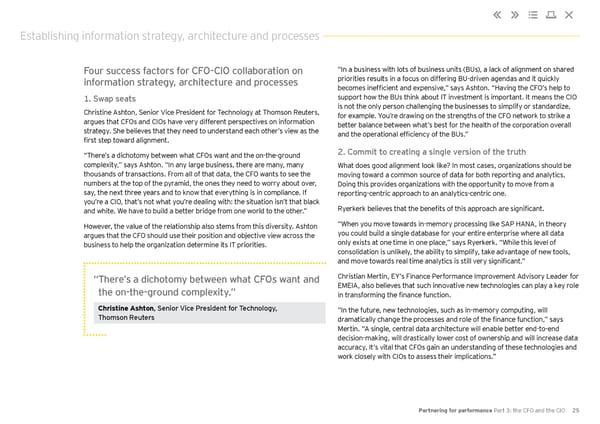Establishing information strategy, architecture and processes Four success factors for CFO-CIO collaboration on “In a business with lots of business units (BUs), a lack of alignment on shared information strategy, architecture and processes priorities results in a focus on differing BU-driven agendas and it quickly becomes inefficient and expensive,” says Ashton. “Having the CFO’s help to 1. Swap seats support how the BUs think about IT investment is important. It means the CIO Christine Ashton, Senior Vice President for Technology at Thomson Reuters, is not the only person challenging the businesses to simplify or standardize, argues that CFOs and CIOs have very different perspectives on information for example. You’re drawing on the strengths of the CFO network to strike a strategy. She believes that they need to understand each other’s view as the better balance between what’s best for the health of the corporation overall first step toward alignment. and the operational efficiency of the BUs.” “There’s a dichotomy between what CFOs want and the on-the-ground 2. Commit to creating a single version of the truth complexity,” says Ashton. “In any large business, there are many, many What does good alignment look like? In most cases, organizations should be thousands of transactions. From all of that data, the CFO wants to see the moving toward a common source of data for both reporting and analytics. numbers at the top of the pyramid, the ones they need to worry about over, Doing this provides organizations with the opportunity to move from a say, the next three years and to know that everything is in compliance. If reporting-centric approach to an analytics-centric one. you’re a CIO, that’s not what you’re dealing with: the situation isn’t that black Ryerkerk believes that the benefits of this approach are significant. and white. We have to build a better bridge from one world to the other.” However, the value of the relationship also stems from this diversity. Ashton “When you move towards in-memory processing like SAP HANA, in theory argues that the CFO should use their position and objective view across the you could build a single database for your entire enterprise where all data business to help the organization determine its IT priorities. only exists at one time in one place,” says Ryerkerk. “While this level of consolidation is unlikely, the ability to simplify, take advantage of new tools, and move towards real time analytics is still very significant.” “ There’s a dichotomy between what CFOs want and Christian Mertin, EY’s Finance Performance Improvement Advisory Leader for the on-the-ground complexity.” EMEIA, also believes that such innovative new technologies can play a key role in transforming the finance function. Christine Ashton, Senior Vice President for Technology, “In the future, new technologies, such as in-memory computing, will Thomson Reuters dramatically change the processes and role of the finance function,” says Mertin. “A single, central data architecture will enable better end-to-end decision-making, will drastically lower cost of ownership and will increase data accuracy. It’s vital that CFOs gain an understanding of these technologies and work closely with CIOs to assess their implications.” Partnering for performance Part 3: the CFO and the CIO 25
 Partnering for Performance Part 3 Page 24 Page 26
Partnering for Performance Part 3 Page 24 Page 26